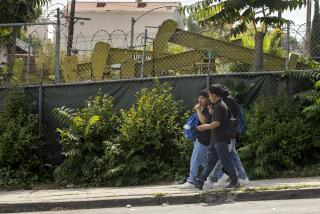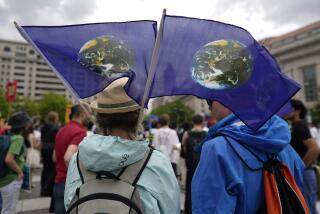The Oil Spill That Sparked the Green Revolution
- Share via
In the winter of 1969, Santa Barbara’s blue waters turned black, its tan beaches turned black and its conscience turned green.
The black--3 million gallons of oil that began leaking Jan. 28 from an offshore drilling site--would eventually be contained. But the green--the color that came to symbolize the environmental movement--would not. Its influence rapidly spread from the tar-stained shores of Santa Barbara to the white marbled halls of Washington.
For the record:
12:00 a.m. Dec. 10, 1999 For the Record
Los Angeles Times Friday December 10, 1999 Home Edition Metro Part B Page 6 Metro Desk 3 inches; 89 words Type of Material: Correction
Oil spill: A Nov. 30 article on the 1969 Santa Barbara oil spill used a quote published at the time that inaccurately reflected an oil executive’s comments. Fred L. Hartley’s actual quote was: “I am always tremendously impressed at the publicity that the death of birds receives versus the loss of people in our country in this day and age. When I think of the folks that gave up their lives when they came down into the ocean off Los Angeles [in a plane crash] some three weeks ago--and the fact that our society forgets that within a 24-hour period--I think relative to that, the fact that we have had no loss of life from this incident is important.”
Within a year of the ecological debacle, landmark environmental legislation was passed to protect the nation’s waters and air. Approvals were also granted for the National Environmental Policy Act, which requires environmental impact reports, and for the establishment of the Environmental Protection Agency.
The pro-environment tide seemed to touch everyone in 1970. At UC Santa Barbara, one of the nation’s first environmental studies departments was established--a lead since followed by scores of campuses around the nation.
At the Sierra Club, membership doubled. And across the country, the first Earth Day was celebrated.
The Santa Barbara oil spill was, in the words of Interior Secretary Bruce Babbitt, “the event that galvanized public awareness of the environment and support for a decade of profound change.”
The flash point for the new consciousness can be traced to a mile-deep spot on the ocean floor, about five miles off the Santa Barbara coast. There the Union Oil Co., now Unocal Corp., was searching--safely, it claimed--for oil.
At the time, federal standards required offshore drilling sites to be outfitted with well casing, a steel lining that helps prevent blowouts, to at least 300 feet below the ocean floor.
But the oil company had obtained a waiver from the U.S. Geological Survey that allowed it to install casing 61 feet shorter.
The federal exemption proved disastrous. When the drilling proceeded into a highly pressurized zone of oil and gas, it caused an explosion so powerful that it cracked the ocean floor in five places.
Oil spewed into the water at the rate of 1,000 gallons per hour for a month before workers could begin to slow it down.
Before it was over, an oil slick coated the coastal waters and stretched 35 miles from Rincon Point, on the Santa Barbara-Ventura County line, to Goleta. The oil was so thick and heavy at some beaches that breaking waves were silent.
It was the worst oil spill in the nation’s history and would remain so until the Exxon Valdez polluted Alaska’s Prince William Sound with 11 million gallons of crude oil in 1989.
*
Despite the severity of the Southern California spill, it’s doubtful whether the event would have sparked a national outcry were it not for television. Just as the medium had done for the antiwar and civil rights movements earlier in the decade, television brought home to the American living room the devastation of the pristine seaside.
Night after night, viewers were sickened by images of oil-drenched birds that couldn’t fly, sea otters that couldn’t swim, and tides that brought in the corpses of dead seals and dolphins.
Fueling public outrage even further was a comment by a top oil company executive who said: “I am amazed at the publicity for the loss of a few birds.”
The spill even prompted a presidential visit to Santa Barbara, which suffered widespread damage to its sea grass and underwater flora. When newly sworn President Richard Nixon saw the tarnished coastline, he remarked that the “incident has frankly touched the conscience of the American people.”
The cleanup was painstaking and slow. Oil was soaked up by using straw and cat litter. (Two decades later, cleanup crews at Prince William Sound would mop up after the Exxon Valdez with diapers.)
It took years for Santa Barbara’s ecosystem to recover.
For a short while, the blame for the oil spill landed all the major players in court. California and local governmental agencies sued the oil company and the U.S. Geological Survey. The parties settled out of court for $10 million.
Of much greater consequence, however, was the decade of unprecedented environmental legislation the spill set into motion. Offshore drilling soon became one of the most heavily regulated industries in California. And nationally, hundreds of laws were enacted to preserve everything from coastlines to endangered species.
More to Read
Sign up for Essential California
The most important California stories and recommendations in your inbox every morning.
You may occasionally receive promotional content from the Los Angeles Times.










